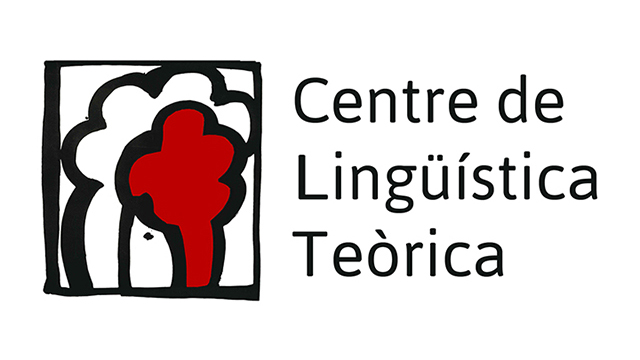
Giuliana Giusti – Weak (in)definites in Italian
Seminari del CLT
Weak (in)definites in Italian
Giuliana Giusti (Università Ca’ Foscari)
Divendres, 11 de febrer de 2022
Hora: 15:30
Aula 402
Enllaç al seminari
The weak (in)definite article in Italian
Italian, like all other Romance languages, distinguishes a definite article l- (henceforth ART) from an indefinite one. With singular count nouns indefiniteness is conveyed by the indefinite article, a form related to the cardinal ‘one’; with plural count nouns and mass nouns, indefiniteness is conveyed by bare nouns or a so-called partitive article formed by the (apparent) preposition de- combine with ART:
(1) a Ho mangiato una mela / la mela. ‘I ate an apple / the apple.’
ART also conveys reference to kind. This is common to all Romance languages (cf. Laca 1990 for Spanish and English, Anscombre 2001 for French):
(2) Adoro *(le) mele / *(la) carne. (‘I love [the] apples / meat’) A third quasi-common trait of Romance (with the exception of French) is bare nouns to express indefiniteness in plural count and singular mass nouns (mele / cioccolata).
Italian, like all other Romance languages, distinguishes a definite article l- (henceforth ART) from an indefinite one. With singular count nouns indefiniteness is conveyed by the indefinite article, a form related to the cardinal ‘one’; with plural count nouns and mass nouns, indefiniteness is conveyed by bare nouns or a so-called partitive article formed by the (apparent) preposition de- combine with ART:
(1) a Ho mangiato una mela / la mela. ‘I ate an apple / the apple.’
ART also conveys reference to kind. This is common to all Romance languages (cf. Laca 1990 for Spanish and English, Anscombre 2001 for French):
(2) Adoro *(le) mele / *(la) carne. (‘I love [the] apples / meat’) A third quasi-common trait of Romance (with the exception of French) is bare nouns to express indefiniteness in plural count and singular mass nouns (mele / cioccolata).
- (3) Ho mangiato mele / carne. (‘I ate apples / meat’)
- (4) J’ai mangé des pommes / de la viande. (‘I ate [of-the] apples / meat’)
Most of the languages that allow for bare nominals also have an overt indefinite determiner at least with count plural nouns. The divide across Romance languages are between those that pluralize ‘one’ (Ibero- Romance and Eastern Romance) and Italian and Gallo-Romance varieties, where the partitive article coexists with bare nouns.
Cardinaletti and Giusti (2016, 2018, 2020) note that in Italian, ART can introduce indefinite nominals, thereby providing three possible realizations for weak indefinites:
(5) a. Ieri abbiamo mangiato mele / carne.
b. Ieri abbiamo mangiato delle mele / della carne.
c. Ieri abbiamo mangiato i biscotti / la carne.
b. Ieri abbiamo mangiato delle mele / della carne.
c. Ieri abbiamo mangiato i biscotti / la carne.
(‘Yesterday, we eat apples’) (‘Yesterday, we eat [of-the] apples’) (‘Yesterday, we eat [the] apples’)
The different possibilities have a different diatopic distribution across Italian dialects and are all available in the colloquial standard with different rates of preferences, mirroring the preferences found in the dialects. Crucially, the definite article in (5c) cannot be reduced to weak definiteness because it is not grammatical with a singular count noun (6a), while weak indefinites generally are (6b-c):
(6) a. #Ieri ho mangiato il biscotto. ‘Yesterday, I ate the apple’ (only definite)
b. Ieri ho comprato la macchina. ‘Yesterday, I bought the car’ (intending: a car)
c. Ieri ho conosciuto la vicina di un mio amico. ‘Yesterday, I met the neighbour of a friend of mine’
ART occurring in indefinite nominal expressions (5b-c), weak indefinites (6b-c) and kind-referring nominals (2) has been unified in different ways in formal semantics, advocating weaking of some of the features composing of definiteness (Roberts 2003, Zamparelli 2002, Donazzan 2013, Leonetti 2019).
This talk will approach the issue from the opposite side, proposing with Carlson and Sussman (2005) that we are dealing with different (silent) determiners in Spec DP concording with a free morpheme realizing nominal features in D.
Appropriate diagnostics will be presented to distinguish across these indefinite determiners, capturing the cross-Romance variation, which is particularly rich across Italo-Romance varieties.
The proposal elaborates on Giusti’s (2002, 2015) treatment of ART as a free functional morpheme encoding a bundle of nominal features (abstract Case, Number, and Gender) in the highest head projected by the nominal spine. Such a morpheme is combined with a determiner in its specifier, which is solely responsible for the interpretation of the nominal expression.
(6) a. #Ieri ho mangiato il biscotto. ‘Yesterday, I ate the apple’ (only definite)
b. Ieri ho comprato la macchina. ‘Yesterday, I bought the car’ (intending: a car)
c. Ieri ho conosciuto la vicina di un mio amico. ‘Yesterday, I met the neighbour of a friend of mine’
ART occurring in indefinite nominal expressions (5b-c), weak indefinites (6b-c) and kind-referring nominals (2) has been unified in different ways in formal semantics, advocating weaking of some of the features composing of definiteness (Roberts 2003, Zamparelli 2002, Donazzan 2013, Leonetti 2019).
This talk will approach the issue from the opposite side, proposing with Carlson and Sussman (2005) that we are dealing with different (silent) determiners in Spec DP concording with a free morpheme realizing nominal features in D.
Appropriate diagnostics will be presented to distinguish across these indefinite determiners, capturing the cross-Romance variation, which is particularly rich across Italo-Romance varieties.
The proposal elaborates on Giusti’s (2002, 2015) treatment of ART as a free functional morpheme encoding a bundle of nominal features (abstract Case, Number, and Gender) in the highest head projected by the nominal spine. Such a morpheme is combined with a determiner in its specifier, which is solely responsible for the interpretation of the nominal expression.
References
Anscombre, J-C. 2001. Le rôle du lexique dans la théorie des stéréotypes. Langages 142: 57-76.
Cardinaletti, A. and G. Giusti. 2016. The syntax of the Italian determiner dei. Lingua 181: 58-80.
Cardinaletti, A. and G. Giusti. 2018. Indefinite determiners: Variation and optionality in Italoromance. In D’Alessandro, R. and Pescarini (eds) Advances in Italian Dialectology, 135-161. Amsterdam: Brill.
Cardinaletti, A. and G. Giusti. 2020. Indefinite determiners in informal Italian. A preliminary analysis. Linguistics 58.3: 679-712.
Carlson, G. and R. S. Sussman. 2005. Seemingly indefinite definites. In Kepsar, S. and M. Reis (eds) Linguistic Evidence, 71-86. Berlin: de Gruyter.
Donazzan, M. 2013. Familiarity constraints on weak definite DPs. Recherches linguistiques de Vincennes 42: 61-90.
Giusti, G. 2002. The functional structure of noun phrases: A bare phrase structure approach. In Cinque G. (ed.) Functional Structure in DP and IP, 54-90. New York / Oxford, OUP.
Giusti, G. 2015. Nominal Syntax at the Interfaces. SCP.
Giusti, G. 2021. A protocol for indefinite determiners in Italian and Italo-Romance. In T. Ihsane (ed.) Disentangling Bare Nouns and Nominals Introduced by a Partitive Article, 262-300. Syntax and Semantics 43. Amsterdam: Brill.
Laca, B. 1990. Generic objects: some more pieces of the puzzle. Lingua 81:25-46.
Leonetti, M. 2019. On weak readings of definite DPs. In N. Pomino (ed.) Morphosyntactic and Semantic Aspects of the DP in Romance and beyond. Arbeits Papiere 135, 1-26. Universitaet Konstanz.
Roberts, C. 2003. Uniqueness in definite noun phrases. Linguistics and Philosophy 26:287-350.
Zamparelli, R. 2002. Definite and bare kind denoting noun phrases. In c. Beyssade et al (eds.) Proceedings of Going Romance 2000, 264-285. Amsterdam: Benjamins.
Anscombre, J-C. 2001. Le rôle du lexique dans la théorie des stéréotypes. Langages 142: 57-76.
Cardinaletti, A. and G. Giusti. 2016. The syntax of the Italian determiner dei. Lingua 181: 58-80.
Cardinaletti, A. and G. Giusti. 2018. Indefinite determiners: Variation and optionality in Italoromance. In D’Alessandro, R. and Pescarini (eds) Advances in Italian Dialectology, 135-161. Amsterdam: Brill.
Cardinaletti, A. and G. Giusti. 2020. Indefinite determiners in informal Italian. A preliminary analysis. Linguistics 58.3: 679-712.
Carlson, G. and R. S. Sussman. 2005. Seemingly indefinite definites. In Kepsar, S. and M. Reis (eds) Linguistic Evidence, 71-86. Berlin: de Gruyter.
Donazzan, M. 2013. Familiarity constraints on weak definite DPs. Recherches linguistiques de Vincennes 42: 61-90.
Giusti, G. 2002. The functional structure of noun phrases: A bare phrase structure approach. In Cinque G. (ed.) Functional Structure in DP and IP, 54-90. New York / Oxford, OUP.
Giusti, G. 2015. Nominal Syntax at the Interfaces. SCP.
Giusti, G. 2021. A protocol for indefinite determiners in Italian and Italo-Romance. In T. Ihsane (ed.) Disentangling Bare Nouns and Nominals Introduced by a Partitive Article, 262-300. Syntax and Semantics 43. Amsterdam: Brill.
Laca, B. 1990. Generic objects: some more pieces of the puzzle. Lingua 81:25-46.
Leonetti, M. 2019. On weak readings of definite DPs. In N. Pomino (ed.) Morphosyntactic and Semantic Aspects of the DP in Romance and beyond. Arbeits Papiere 135, 1-26. Universitaet Konstanz.
Roberts, C. 2003. Uniqueness in definite noun phrases. Linguistics and Philosophy 26:287-350.
Zamparelli, R. 2002. Definite and bare kind denoting noun phrases. In c. Beyssade et al (eds.) Proceedings of Going Romance 2000, 264-285. Amsterdam: Benjamins.



